
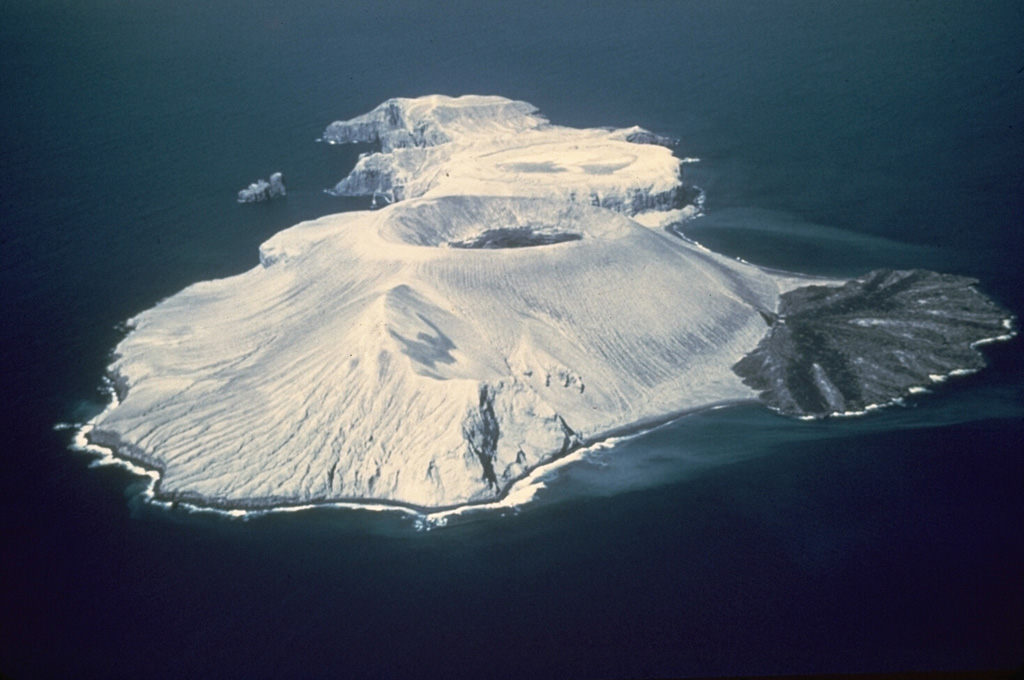
The Global Volcanism Program has no activity reports available for Bárcena.
The Global Volcanism Program has no Weekly Reports available for Bárcena.
The Global Volcanism Program has no Bulletin Reports available for Bárcena.
|
|
||||||||||||||||||||||||||
There is data available for 1 confirmed Holocene eruptive periods.
1952 Aug 1 - 1953 Feb 24 ± 4 days Confirmed Eruption (Explosive / Effusive) VEI: 3
| Episode 1 | Eruption (Explosive / Effusive) | South end of Isla San Benedicto | |||||||||||||||||||||||||||||||||||||||||||||||||||||||||||||||||||||||||||||||
|---|---|---|---|---|---|---|---|---|---|---|---|---|---|---|---|---|---|---|---|---|---|---|---|---|---|---|---|---|---|---|---|---|---|---|---|---|---|---|---|---|---|---|---|---|---|---|---|---|---|---|---|---|---|---|---|---|---|---|---|---|---|---|---|---|---|---|---|---|---|---|---|---|---|---|---|---|---|---|---|---|
| 1952 Aug 1 - 1953 Feb 24 ± 4 days | Evidence from Observations: Reported | |||||||||||||||||||||||||||||||||||||||||||||||||||||||||||||||||||||||||||||||
|
List of 14 Events for Episode 1 at South end of Isla San Benedicto
|
||||||||||||||||||||||||||||||||||||||||||||||||||||||||||||||||||||||||||||||||
This compilation of synonyms and subsidiary features may not be comprehensive. Features are organized into four major categories: Cones, Craters, Domes, and Thermal Features. Synonyms of features appear indented below the primary name. In some cases additional feature type, elevation, or location details are provided.
Synonyms |
||||
| Boquerón, El | San Benedicto Island | ||||
Cones |
||||
| Feature Name | Feature Type | Elevation | Latitude | Longitude |
| Montículo Cinerítico | Tuff cone | 297 m | 19° 18' 0.00" N | 110° 49' 0.00" W |
Domes |
||||
| Feature Name | Feature Type | Elevation | Latitude | Longitude |
| Herrera, Crater | Dome | 19° 18' 29.00" N | 110° 49' 0.00" W | |
| López de Villalobos, Cerro | Dome | 19° 18' 0.00" N | 110° 49' 0.00" W | |
| Roca Challenger | Dome | 19° 18' 0.00" N | 110° 49' 0.00" W | |
| Rocas Trinidad | Dome | 19° 19' 0.00" N | 110° 49' 0.00" W | |
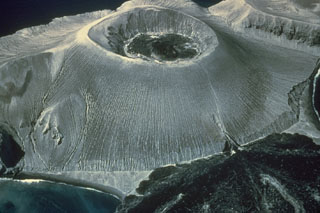 An aerial view from the SE shows the Bárcena tuff cone, constructed during an eruption in the Revillagigedo Islands off the western coast of México during 1952-53. The 700-m-wide crater is partially filled by lava, and the lava delta at the lower right was fed from a vent on the flank. The tuff cone was constructed to a height of about 330 m from near sea level within the first few weeks of an eruption that began on 1 August. Lava was seen in the crater by mid-September and flank lava extrusion began on 8 December.
An aerial view from the SE shows the Bárcena tuff cone, constructed during an eruption in the Revillagigedo Islands off the western coast of México during 1952-53. The 700-m-wide crater is partially filled by lava, and the lava delta at the lower right was fed from a vent on the flank. The tuff cone was constructed to a height of about 330 m from near sea level within the first few weeks of an eruption that began on 1 August. Lava was seen in the crater by mid-September and flank lava extrusion began on 8 December. Bárcena volcano forms the elongate island of San Benedicto, seen here from the SW in March 1955. The circular summit crater at the center and the lava delta to the right of the tuff cone formed during an eruption in 1952-53. Pleistocene lava domes are located at the far NE tip of the island. Dark-colored lava from the 1952-53 eruption can be seen in the summit crater.
Bárcena volcano forms the elongate island of San Benedicto, seen here from the SW in March 1955. The circular summit crater at the center and the lava delta to the right of the tuff cone formed during an eruption in 1952-53. Pleistocene lava domes are located at the far NE tip of the island. Dark-colored lava from the 1952-53 eruption can be seen in the summit crater.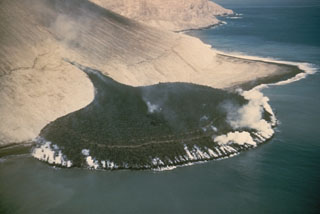 A steaming lava flow issuing from a fissure on the SE flank of Bárcena volcano, in the Revillagigedo Islands west of México, forms a peninsula about 300 m wide that extends about 230 m out to sea. This photo from the SE on 11 December 1952 was taken three days after the beginning of lava extrusion. By the time the eruption ended in February 1953 the lava delta had extended the shoreline by 700 m.
A steaming lava flow issuing from a fissure on the SE flank of Bárcena volcano, in the Revillagigedo Islands west of México, forms a peninsula about 300 m wide that extends about 230 m out to sea. This photo from the SE on 11 December 1952 was taken three days after the beginning of lava extrusion. By the time the eruption ended in February 1953 the lava delta had extended the shoreline by 700 m.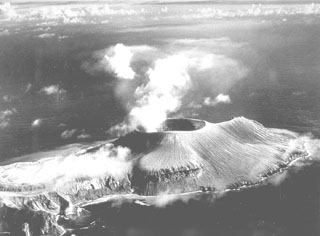 This aerial view from the west shows the new Volcán Bárcena summit crater producing a plume. The 700-m-wide crater had grown to a height of about 380 m in the first two weeks of the eruption. At the time of this 20 September 1952 photo, taken about seven weeks after the start of the eruption, the first of two lava domes had emerged in the summit crater. Extrusion of a lava flow that formed a delta on the far SE side of the island had not yet begun.
This aerial view from the west shows the new Volcán Bárcena summit crater producing a plume. The 700-m-wide crater had grown to a height of about 380 m in the first two weeks of the eruption. At the time of this 20 September 1952 photo, taken about seven weeks after the start of the eruption, the first of two lava domes had emerged in the summit crater. Extrusion of a lava flow that formed a delta on the far SE side of the island had not yet begun.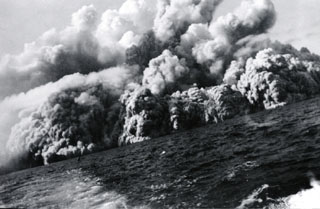 Pyroclastic surges at about 0805 on 1 August 1952 travel across the sea at the western coast of the island, 20 minutes after the start of the eruption. Several inches of ash and lapilli up to 12 mm in diameter fell on the deck of the fishing boat from which this photo was taken as it sailed away from the volcano at full speed.
Pyroclastic surges at about 0805 on 1 August 1952 travel across the sea at the western coast of the island, 20 minutes after the start of the eruption. Several inches of ash and lapilli up to 12 mm in diameter fell on the deck of the fishing boat from which this photo was taken as it sailed away from the volcano at full speed.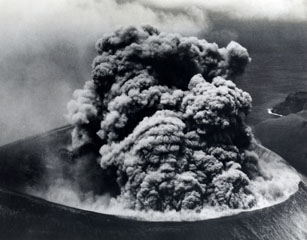 A Vulcanian ash plume rises from the Bárcena crater on 9 September 1952, more than a month after the start of the eruption. The roughly 300-m-wide crater is seen here from the east. Explosions producing eruption columns that rose to about 600 m above sea level were observed at 20-minute intervals, along with occasional small pyroclastic surges that swept down the flanks of the cone and sometimes reached the coast. The roar of the eruption was heard above the noise of the plane's engine.
A Vulcanian ash plume rises from the Bárcena crater on 9 September 1952, more than a month after the start of the eruption. The roughly 300-m-wide crater is seen here from the east. Explosions producing eruption columns that rose to about 600 m above sea level were observed at 20-minute intervals, along with occasional small pyroclastic surges that swept down the flanks of the cone and sometimes reached the coast. The roar of the eruption was heard above the noise of the plane's engine.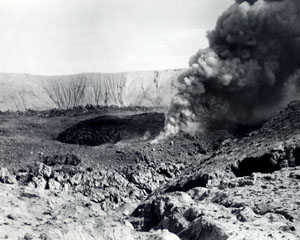 A small eruption on 10 December 1952 took place from the moat between the inner (dark-colored) and outer lava domes in the Bárcena summit crater. A lava dome was first observed on 20 September, when it was about 8 m high and 55 m wide. On 15 November the dome was observed to fill about half of the 700-m-wide crater. At the time of this photo, an older outer dome littered with breadcrust bombs and ejecta surrounded the new inner dome.
A small eruption on 10 December 1952 took place from the moat between the inner (dark-colored) and outer lava domes in the Bárcena summit crater. A lava dome was first observed on 20 September, when it was about 8 m high and 55 m wide. On 15 November the dome was observed to fill about half of the 700-m-wide crater. At the time of this photo, an older outer dome littered with breadcrust bombs and ejecta surrounded the new inner dome. 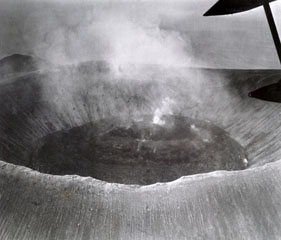 An overflight on 15 November 1952 shows the Bárcena crater half-filled with viscous lava. Sporadic small explosions were observed during the overflight, and continuous weak steam emission took place from the center of the dome. Montículo Cinerítico in the background and to the left is an eroded cone at the southern tip of the island that formed before the 1952 eruption.
An overflight on 15 November 1952 shows the Bárcena crater half-filled with viscous lava. Sporadic small explosions were observed during the overflight, and continuous weak steam emission took place from the center of the dome. Montículo Cinerítico in the background and to the left is an eroded cone at the southern tip of the island that formed before the 1952 eruption.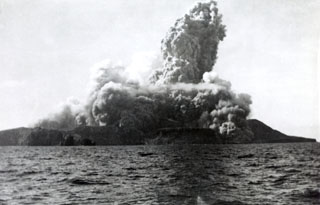 A new cone, Volcán Bárcena, was rapidly constructed during an eruption that began on 1 August 1952 at the southern end of Isla San Benedicto. This photo, taken from off the west coast of the island only four minutes after the start of the eruption, also shows the onset of pyroclastic surges. Lava extrusion occurred in September, November, and December. On 8 December activity shifted to a vent on the SE flank, producing a lava delta that extended about 700 m to sea. Activity ended in late February 1953.
A new cone, Volcán Bárcena, was rapidly constructed during an eruption that began on 1 August 1952 at the southern end of Isla San Benedicto. This photo, taken from off the west coast of the island only four minutes after the start of the eruption, also shows the onset of pyroclastic surges. Lava extrusion occurred in September, November, and December. On 8 December activity shifted to a vent on the SE flank, producing a lava delta that extended about 700 m to sea. Activity ended in late February 1953.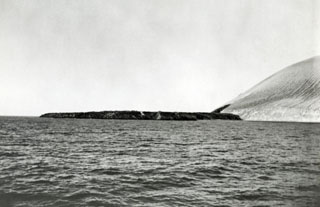 This lava delta formed during the 1952-53 eruption, seen here from the NE. The Delta Lávico flow extended 700 m out to sea on the SE side of Isla San Benedicto and formed a peninsula about 1.2 km wide. The lava can be seen extruding from the vent on the lower SE flank. The eruption began on 8 December and by the following morning the lava flow had reached the coast. Lava effusion continued into February 1953.
This lava delta formed during the 1952-53 eruption, seen here from the NE. The Delta Lávico flow extended 700 m out to sea on the SE side of Isla San Benedicto and formed a peninsula about 1.2 km wide. The lava can be seen extruding from the vent on the lower SE flank. The eruption began on 8 December and by the following morning the lava flow had reached the coast. Lava effusion continued into February 1953.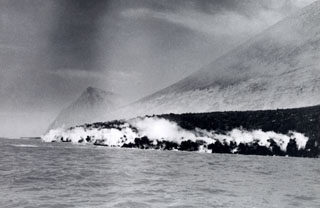 Entry of the Delta Lávico lava flow into the sea produces steam along the flow margins. The flow originated from a vent low on the Volcán Bárcena 1952-53 tuff cone. Punta Sur, the southernmost tip of the island, is in the left background and is a Montículo Cinerítico tuff cone that formed prior to the 1952 eruption and was formerly the highest point on the island.
Entry of the Delta Lávico lava flow into the sea produces steam along the flow margins. The flow originated from a vent low on the Volcán Bárcena 1952-53 tuff cone. Punta Sur, the southernmost tip of the island, is in the left background and is a Montículo Cinerítico tuff cone that formed prior to the 1952 eruption and was formerly the highest point on the island.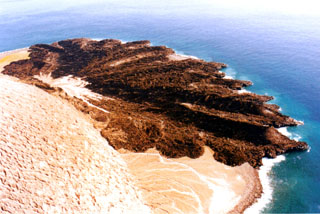 Wave erosion rapidly modified the once smooth coastal margin of the lava delta that erupted in 1952-53. The vent that produced the flow is to the left at the base of the light-colored tuff cone that also formed during the eruption. The Delta Lávico flow extended 700 m out to sea and formed a peninsula about 1.2 km wide.
Wave erosion rapidly modified the once smooth coastal margin of the lava delta that erupted in 1952-53. The vent that produced the flow is to the left at the base of the light-colored tuff cone that also formed during the eruption. The Delta Lávico flow extended 700 m out to sea and formed a peninsula about 1.2 km wide.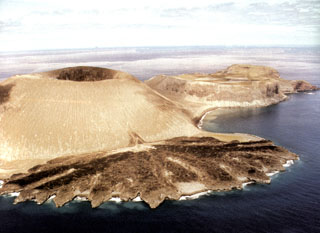 The Delta Lávico flow forms a peninsula on the SE flank of Volcán Bárcena at the southern end of San Benedicto Island. The tuff cone and lava flow formed during the 1952-53 eruption. The flat-topped cone to the right is Cráter Herrera, a lava dome with crater. Another lava dome, Roca Challenger, forms the northern tip of the island beyond Cráter Herrera.
The Delta Lávico flow forms a peninsula on the SE flank of Volcán Bárcena at the southern end of San Benedicto Island. The tuff cone and lava flow formed during the 1952-53 eruption. The flat-topped cone to the right is Cráter Herrera, a lava dome with crater. Another lava dome, Roca Challenger, forms the northern tip of the island beyond Cráter Herrera.The following 42 samples associated with this volcano can be found in the Smithsonian's NMNH Department of Mineral Sciences collections, and may be availble for research (contact the Rock and Ore Collections Manager). Catalog number links will open a window with more information.
| Catalog Number | Sample Description | Lava Source | Collection Date |
|---|---|---|---|
| NMNH 109392-1 | Soda Trachyte | -- | -- |
| NMNH 109392-10 | Soda Trachyte | -- | -- |
| NMNH 109392-11 | Soda Trachyte | -- | -- |
| NMNH 109392-12 | Trachyandesite | -- | -- |
| NMNH 109392-13 | Trachyandesite | -- | -- |
| NMNH 109392-14 | Soda Trachyte | -- | -- |
| NMNH 109392-15 | Pumice | -- | -- |
| NMNH 109392-16 | Trachyte | -- | -- |
| NMNH 109392-17 | Trachyte | -- | -- |
| NMNH 109392-18 | Trachyandesite | -- | -- |
| NMNH 109392-19 | Soda Rhyolite | -- | -- |
| NMNH 109392-2 | Soda Trachyte | -- | -- |
| NMNH 109392-20 | Trachyte | -- | -- |
| NMNH 109392-21 | Soda Rhyolite | -- | -- |
| NMNH 109392-22 | Soda Trachyte | -- | -- |
| NMNH 109392-23 | Basalt | -- | -- |
| NMNH 109392-24 | Soda Trachyte | -- | -- |
| NMNH 109392-25 | Trachyandesite | -- | -- |
| NMNH 109392-26 | Trachyte | -- | -- |
| NMNH 109392-27 | Trachyte | -- | -- |
| NMNH 109392-28 | Trachyte (?) | -- | -- |
| NMNH 109392-29 | Unidentified | -- | -- |
| NMNH 109392-3 | Soda Trachyte | -- | -- |
| NMNH 109392-30 | Unidentified | -- | -- |
| NMNH 109392-31 | Andesite | -- | -- |
| NMNH 109392-32 | Trachyte | -- | -- |
| NMNH 109392-33 | Soda Trachyte | -- | -- |
| NMNH 109392-34 | Soda Trachyte | -- | -- |
| NMNH 109392-35 | Trachyandesite | -- | -- |
| NMNH 109392-36 | Pumice | -- | -- |
| NMNH 109392-37 | Trachyandesite | -- | -- |
| NMNH 109392-38 | Trachyandesite | -- | -- |
| NMNH 109392-4 | Soda Trachyte | -- | -- |
| NMNH 109392-5 | Soda Trachyte | -- | -- |
| NMNH 109392-6 | Soda Trachyte | -- | -- |
| NMNH 109392-7 | Soda Trachyte | -- | -- |
| NMNH 109392-8 | Olivine Trachybasalt | -- | -- |
| NMNH 109392-9 | Trachyte | -- | -- |
| NMNH 117450-38 | Scoria | -- | -- |
| NMNH 117450-39 | Pumice | -- | -- |
| NMNH 117450-40 | Pumice | -- | -- |
| NMNH 117450-41 | Pumice | -- | -- |
| Copernicus Browser | The Copernicus Browser replaced the Sentinel Hub Playground browser in 2023, to provide access to Earth observation archives from the Copernicus Data Space Ecosystem, the main distribution platform for data from the EU Copernicus missions. |
| MIROVA | Middle InfraRed Observation of Volcanic Activity (MIROVA) is a near real time volcanic hot-spot detection system based on the analysis of MODIS (Moderate Resolution Imaging Spectroradiometer) data. In particular, MIROVA uses the Middle InfraRed Radiation (MIR), measured over target volcanoes, in order to detect, locate and measure the heat radiation sourced from volcanic activity. |
| MODVOLC Thermal Alerts | Using infrared satellite Moderate Resolution Imaging Spectroradiometer (MODIS) data, scientists at the Hawai'i Institute of Geophysics and Planetology, University of Hawai'i, developed an automated system called MODVOLC to map thermal hot-spots in near real time. For each MODIS image, the algorithm automatically scans each 1 km pixel within it to check for high-temperature hot-spots. When one is found the date, time, location, and intensity are recorded. MODIS looks at every square km of the Earth every 48 hours, once during the day and once during the night, and the presence of two MODIS sensors in space allows at least four hot-spot observations every two days. Each day updated global maps are compiled to display the locations of all hot spots detected in the previous 24 hours. There is a drop-down list with volcano names which allow users to 'zoom-in' and examine the distribution of hot-spots at a variety of spatial scales. |
|
WOVOdat
Single Volcano View Temporal Evolution of Unrest Side by Side Volcanoes |
WOVOdat is a database of volcanic unrest; instrumentally and visually recorded changes in seismicity, ground deformation, gas emission, and other parameters from their normal baselines. It is sponsored by the World Organization of Volcano Observatories (WOVO) and presently hosted at the Earth Observatory of Singapore.
GVMID Data on Volcano Monitoring Infrastructure The Global Volcano Monitoring Infrastructure Database GVMID, is aimed at documenting and improving capabilities of volcano monitoring from the ground and space. GVMID should provide a snapshot and baseline view of the techniques and instrumentation that are in place at various volcanoes, which can be use by volcano observatories as reference to setup new monitoring system or improving networks at a specific volcano. These data will allow identification of what monitoring gaps exist, which can be then targeted by remote sensing infrastructure and future instrument deployments. |
| Volcanic Hazard Maps | The IAVCEI Commission on Volcanic Hazards and Risk has a Volcanic Hazard Maps database designed to serve as a resource for hazard mappers (or other interested parties) to explore how common issues in hazard map development have been addressed at different volcanoes, in different countries, for different hazards, and for different intended audiences. In addition to the comprehensive, searchable Volcanic Hazard Maps Database, this website contains information about diversity of volcanic hazard maps, illustrated using examples from the database. This site is for educational purposes related to volcanic hazard maps. Hazard maps found on this website should not be used for emergency purposes. For the most recent, official hazard map for a particular volcano, please seek out the proper institutional authorities on the matter. |
| IRIS seismic stations/networks | Incorporated Research Institutions for Seismology (IRIS) Data Services map showing the location of seismic stations from all available networks (permanent or temporary) within a radius of 0.18° (about 20 km at mid-latitudes) from the given location of Bárcena. Users can customize a variety of filters and options in the left panel. Note that if there are no stations are known the map will default to show the entire world with a "No data matched request" error notice. |
| UNAVCO GPS/GNSS stations | Geodetic Data Services map from UNAVCO showing the location of GPS/GNSS stations from all available networks (permanent or temporary) within a radius of 20 km from the given location of Bárcena. Users can customize the data search based on station or network names, location, and time window. Requires Adobe Flash Player. |
| DECADE Data | The DECADE portal, still in the developmental stage, serves as an example of the proposed interoperability between The Smithsonian Institution's Global Volcanism Program, the Mapping Gas Emissions (MaGa) Database, and the EarthChem Geochemical Portal. The Deep Earth Carbon Degassing (DECADE) initiative seeks to use new and established technologies to determine accurate global fluxes of volcanic CO2 to the atmosphere, but installing CO2 monitoring networks on 20 of the world's 150 most actively degassing volcanoes. The group uses related laboratory-based studies (direct gas sampling and analysis, melt inclusions) to provide new data for direct degassing of deep earth carbon to the atmosphere. |
| Large Eruptions of Bárcena | Information about large Quaternary eruptions (VEI >= 4) is cataloged in the Large Magnitude Explosive Volcanic Eruptions (LaMEVE) database of the Volcano Global Risk Identification and Analysis Project (VOGRIPA). |
| EarthChem | EarthChem develops and maintains databases, software, and services that support the preservation, discovery, access and analysis of geochemical data, and facilitate their integration with the broad array of other available earth science parameters. EarthChem is operated by a joint team of disciplinary scientists, data scientists, data managers and information technology developers who are part of the NSF-funded data facility Integrated Earth Data Applications (IEDA). IEDA is a collaborative effort of EarthChem and the Marine Geoscience Data System (MGDS). |